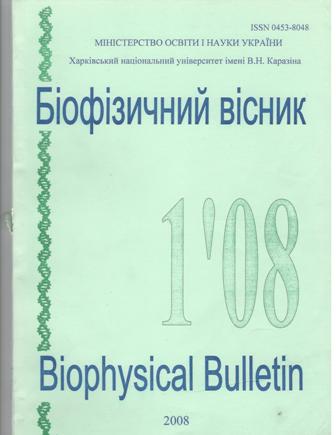Lanthanide effect on physicochemical properties of lipid bilayer as revealed by indicator dye bromothymol blue
Abstract
The development of new formulations of antineoplastic drugs currently represents an extensively growing research area. The efficiency of existing anti-tumor drugs is frequently limited by their high general toxicity, metabolic instability in an organism, and bad penetration into a cancer cell. Besides, insignificant direct influence on tumoral growth also limits the application of antineoplastic drugs in a free form. One efficient way of drug delivery is based on the use of lipid vesicles (liposomes). Liposomes are spherical, self-closed structures formed by one or several concentric lipid bilayers with an aqueous phase inside and between the lipid bilayers. The lipid bilayer favors the solubilization of hydrophobic compounds, whereas the internal aqueous phase of lipid vesicles is suitable for the encapsulation of hydrophilic drugs. The design of liposomal carriers is heavily based on the evaluation of bilayer-modifying properties of the drug. This is important not only for achieving maximum payload without compromising liposome stability but also for the prediction of therapeutic and toxic effects of a certain compound, because membrane interactions may prove critical for drug absorption, distribution, metabolism, and elimination in an organism. In the present work, the effect of the two potential antineoplastic drugs - europium coordination complexes (LC) - on the physicochemical properties of phosphatidylcholine (PC) model membranes has been investigated using the environmentally-sensitive pH indicator dye bromothymol blue (BTB). This dye responds to the changes in environmental conditions by the shifts of its protolytic and partition equilibrium. Incorporation of LC into the lipid vesicles was found to exert no influence on the effective electrostatic potential of model membranes, i.e. the mean potential at the location of the dye prototropic moiety in the interfacial region. In contrast, BTB membrane partitioning markedly enhanced in the presence of drugs, indicating that europium coordination complexes can affect the molecular organization of a lipid bilayer, presumably through the generation of structural defects and altering the conformation of PC headgroups. High lipophilicity of Eu(III) coordination complexes together with their relatively weak membrane-modifying propensities create prerequisites for the development of liposomal formulations of these compounds.
Downloads
References
2. N. Mignet et al. // Eur. Biophys. J. 2006.V. 35. P. 155-161.
3. A. Avdeev // Absorption and Drug Development: Solubility, Permeability, and Charge State. John Wiley & Sons, 2003,287 p.
4. J.K. Seydel, M. Wiese // Drug-membrane interactions, Wiley-VCH, 2002, 337 p.
5. G. Momekov et al. // Medicinal Chemistry. 2006. V. 2. P. 439-445.
6. B. Mui, L. Chow, M.J. Hope // Meth. Enzymol. 2003. V. 367. P. 3-14.
7. G. Bartlett // J. Biol. Chem. 1959. V.234. P. 466-468.
8. E. Antonini et al. // Biochim. Biophys. Acta. 1963. V. 71. P. 124-138.
9. T. Mashimo, I. Uede // Proc. Natl. Acad. Sci. USA. 1979. V. 76. P. 5114-5118.
10. G. Gorbenko // Biochim. Biophys. Acta. 1998. V. 1370. P. 107-118.
11.G. Gorbenko et al. // J. Chem. Soc. Faraday Trans. 1998. V. 94. P. 2117-2125.
12. K. Colonna et. al. // Arch. Biochem. Bioahys. 1972. V. 151. P. 295-303.
Authors who publish with this journal agree to the following terms:
- Authors retain copyright and grant the journal right of first publication with the work simultaneously licensed under a Creative Commons Attribution License that allows others to share the work with an acknowledgement of the work's authorship and initial publication in this journal.
- Authors are able to enter into separate, additional contractual arrangements for the non-exclusive distribution of the journal's published version of the work (e.g., post it to an institutional repository or publish it in a book), with an acknowledgement of its initial publication in this journal.
- Authors are permitted and encouraged to post their work online (e.g., in institutional repositories or on their website) prior to and during the submission process, as it can lead to productive exchanges, as well as earlier and greater citation of published work (See The Effect of Open Access).





